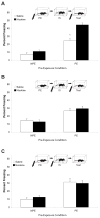Nicotine enhances context learning but not context-shock associative learning
- PMID: 18823171
- PMCID: PMC2559949
- DOI: 10.1037/a0012807
Nicotine enhances context learning but not context-shock associative learning
Abstract
Nicotine has been found to enhance learning in a variety of tasks, including contextual fear conditioning. During contextual fear conditioning animals have to learn the context and associate the context with an unconditioned stimulus (footshock). As both of these types of learning co-occur during fear conditioning, it is not clear whether nicotine enhances one or both of these types of learning. To tease these two forms of learning apart, the authors made use of the context preexposure facilitation effect (CPFE). Acquisition of the CPFE requires that contextual and context-shock learning occurs on separate days, allowing for their individual manipulation. Nicotine (0.09 mg/kg) administered prior to contextual learning and retrieval enhanced the CPFE whereas administration prior to context-shock learning and retrieval had no effect. Thus, nicotine enhances contextual learning but not context-shock associative learning. Finally, the results are discussed in terms of a theory of how nicotine could alter hippocampal-cortical-amygdala interactions to facilitate contextual learning.
Figures





References
-
- Alkondon M, Albuquerque EX. Diversity of nicotinic acetylcholine receptors in rat hippocampal neurons. I. Pharmacological and functional evidence for distinct structural subtypes. Journal of Pharmacology and Experimental Therapeutics. 1993;265:1455–1473. - PubMed
-
- Alkondon M, Albuquerque EX. Nicotinic acetylcholine receptor alpha7 and alpha4beta2 subtypes differentially control GABAergic input to CA1 neurons in rat hippocampus. Journal of Neurophysiology. 2001;86:3043–3055. - PubMed
-
- Alkondon M, Albuquerque EX. The nicotinic acetylcholine receptor subtypes and their function in the hippocampus and cerebral cortex. Progress in Brain Research. 2004;145:109–120. - PubMed
Publication types
MeSH terms
Substances
Grants and funding
LinkOut - more resources
Full Text Sources
Research Materials

